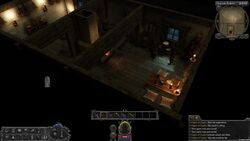RPG Codex Review: Valkyria Chronicles
RPG Codex Review: Valkyria Chronicles
Review - posted by Crooked Bee on Tue 6 January 2015, 19:04:32
Tags: SEGA; Valkyria Chronicles[Review by WhiskeyWolf; edited by Darth Roxor]
Valkyria Chronicles is a formerly PS3-exclusive tactical roleplaying game, originally released by SEGA in the second half of 2008. While not exactly a flop, its sales were poor outside of Japan, even though the game received favorable reviews from the gaming press. The following year saw a noticeable rise in sales that could be attributed to factors such as positive word-of-mouth, a drop in price and the release of an anime based on the game.
Ultimately, SEGA decided to authorize two additional games in the series for the PlayStation Portable, of which the third one was not officially released in the West, because of the – again – disappointing sales of Valkyria Chronicles 2. That of course did not stop the fans from translating it themselves, as Valkyria Chronicles already had a strong cult-following by that time. Regardless, it seemed that this would be as far as the franchise would go. Yet fate had other things in store.
Unbeknownst to most, SEGA was keeping the franchise alive in Japan. After the release of Valkyria Chronicles 3 Extra Edition around the end of 2011, there was also the browser/mobile-based card game Valkyria Chronicles Duel (2012) and Project X Zone (2013). Published by Namco for the 3DS, Project X Zone was not a proper part of the series, but a crossover game that featured some of the VC characters. It was, however, a TRPG and sold way more in the West than projected.
Then something happened... The planets aligned, old game franchise necrophilia was outlawed, Grimoire finally came out, while someone high enough in the SEGA hierarchy looked upon their console games catalogue and the growing trends in online sales and thought, “Hmm…”. The unthinkable happened - SEGA discovered the PC.
With porting underway, the project was placed under tighter security than the plan to attack the U.S. Pacific Fleet in Pearl Harbor, probably because of the fear that people would think SEGA was insane to actually sink money into this borderline experimental concept of bringing old console games onto that so-called ‘insignificant’ PC market. On the 28th of October, 2014, the bombs fell to the general feeling of surprise and shock, and Valkyria Chronicles was announced for the PC with only a single blip of warning on the PEGI radar. The game was released barely two weeks later.
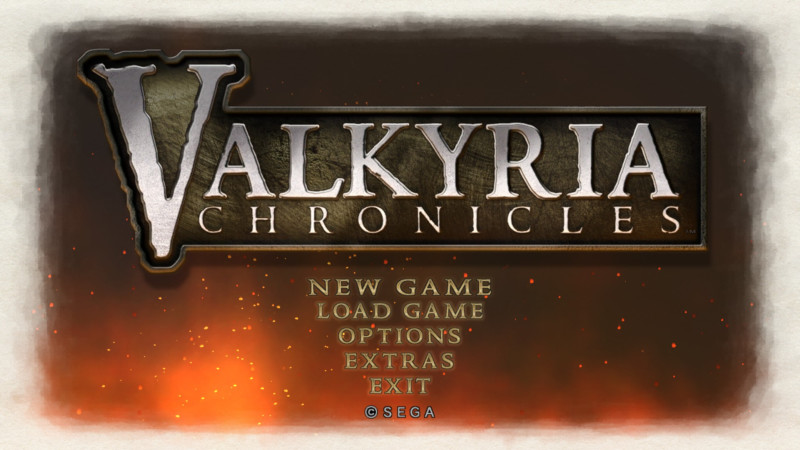
Valkyria Chronicles is something that probably could not have gestated outside of that divergent, wonderful and perverted country that is Japan. Mainly because the whole game is basically composed of a few chapters taken from the European 20th century history books, mixed with the usual assortment of typical Japanese clichés that seem to plague their every medium like some relentless bullet-point list bestowed upon them by the gods themselves. You will not see a Western developer doing this, especially as the game goes into some of those touchy subjects like, say, racial discrimination, genocide and other such stuff. Not a safe topic to be sure, better make a dumb World War 2 shooter instead and avoid themes that could offend someone, somewhere, regardless of your best intentions. It is not good for business.
The game takes place in Europa, which is a fictional depiction of Europe. The year is 1935 and the continent is dominated by two superpowers: The commonwealth of allied democracies known as the Atlantic Federation (think NATO) in the west and The Autocratic East Europan Imperial Alliance in the east. Caught between those two giants is the Principality of Gallia, a small, neutral country that possesses large deposits of Ragnite, a mineral crucial enough for a growing economy to have been the main driving force behind the First Europan War twenty years ago. If you somehow did not notice, Gallia is basically the Low Countries (Belgium, The Netherlands and Luxembourg) and Ragnite – with its multiple applications in different fields, ranging from powering engines to medicine – is oil.

The game starts after the beginning of the Second Europan War. With the Federation on the defensive, the Empire decides to invade Gallia with the objective to secure a steady source of Ragnite to sustain its war effort. Here we are introduced to the two main leads, Welkin and Alicia, as they are forced to evacuate from their hometown of Bhrul. Bhrul is located on the border with the Empire and is one of the first places to fall in the face of the sudden offensive. From there, they move to Randgriz, the capital city, and join the militia forces. Being a university student, Welkin had finished a mandatory officer's course, which is why he now gets promoted to lieutenant and given command over Squad 7 with Alicia as his non-com officer.
I think it is important to point out that Valkyria Chronicles is one of the few games that have a legitimate, honest-to-god reason to have underage characters as protagonists. Gallia’s universal conscription (probably based on the Swiss model) requires that all able-bodied male and female citizens join the militia and fight alongside the regular army in times of war. Thanks to this policy, even a small country like Gallia managed to defend its independence in the First Europan War.
From here on out, your task as the player will be to lead men and women under your command through a series of battles and skirmishes, while trying not to get half of your squad killed in the process. All in all, it is a fairly straightforward introduction that clearly establishes the final objective you will strive to achieve throughout the game - repel the Empire. It also presents you with a few short battles that will acquaint you with the basic gameplay.
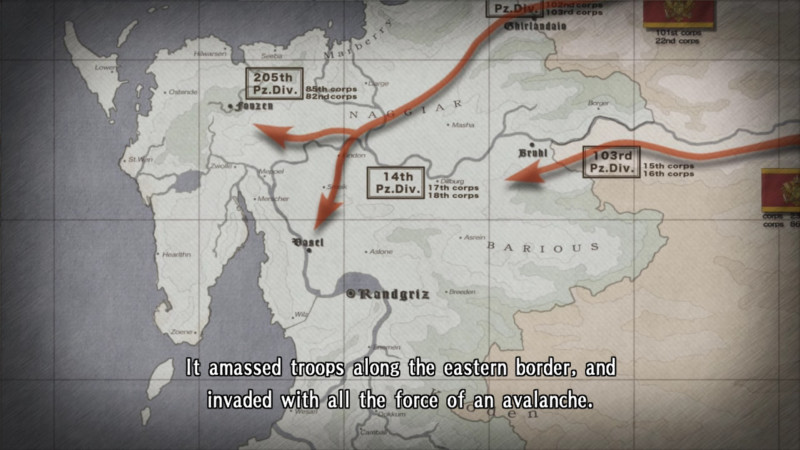
Probably one of the main advantages of Valkyria Chronicles is its unique tactical turn-based system that, while not diverging from the standard formula for games of this type, still manages to alter the perspective of certain elements radically enough to gain a dynamic never before seen in any turn-based game. The difference is profound and, what is more important, it works. Most of the time.
The Battle of Live Tactical Zones (BLiTZ) divides the battle into two modes. The first one is the Command Mode where you are able to oversee the battlefield from above, as if you were looking on a map. All your units are marked on it, as well as the enemy units that are within the line of sight of your forces. Apart from giving you the general feel of the tactical situation, this mode also allows you to issue Orders and allocate Command Points. Command Points are – as the name would imply – points which are issued every turn to you and the enemy. Each point allows one of your units to take action (two points are required if said unit is a tank). Orders are mostly, but not only, stat related boosts, and require various amounts of points to issue. You only have a few at your disposal at the beginning, but you can acquire new ones as the game progresses.

So far, this is pretty much the standard TRPG formula. That is, until you issue a Command Point to one of your units. As soon as you do that, the view shifts to a third person perspective, and the gameplay becomes sort of pseudo-real time where you are able to directly control the chosen unit. This is the Action Mode. Please note that this does not make it a third person shooter, as movement and shooting are done separately. Once in direct control, your unit is entitled to a certain distance it can move and a single action it can perform (there are some environment related events that do not use up the action). All this depends on the class of the unit you are currently using. Suffice to say, most of the ‘actions’ that you will be performing are about making the other guy die for his country.
There are five infantry classes in the game:
- The Scout is armed with a medium-long range semi-automatic rifle, has weak body-armor and will most likely not survive if left in the open, but, compared to the other classes, its main advantage comes from being able to travel the longest distance in combat.
- The Shocktrooper is equipped with a submachine gun and sports heavy armor. This is the deadliest class in the game when encountered at close range, and its only drawback is its relatively short movement range.
- The Lancer, with its AT lance and the best armor in the game, is your primary anti-tank unit. Its movement range is comparable to that of a Shocktrooper, which makes it of limited use when facing infantry.
- The Engineer is similar to a Scout but even weaker combat-wise. This unit is able to repair your command tank, disarm mines, refill sandbags, and resupply ammo to your troops.
- The Sniper is unable to withstand any kind of damage and has by far the most limited movement of all classes, but is essential in eliminating enemies from afar.
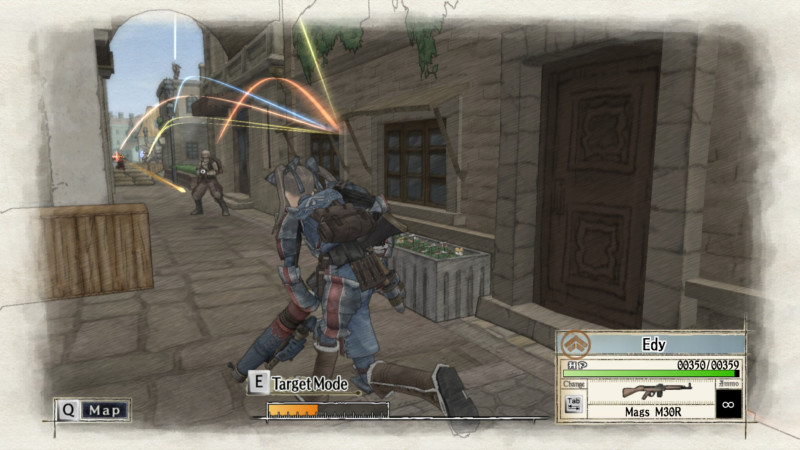
Now, if you are familiar with some of the classic western TRPGs – like Jagged Alliance or X-COM – you will be familiar with the term ‘Overwatch’ or ‘Reaction Fire’. The developers of Valkyria Chronicles decided to use a similar mechanic… minus the action points. While in Action Mode, if you get too close to an enemy solider that is facing your way, he will fire upon you even though it is not his turn (this does not apply to Lancers and Snipers). And he will keep firing until you get out of range, your unit takes too much damage and gets downed, or you shift into the aiming stance. This reactive fire mechanic, which applies to both enemy and player units depending on whose turn it is, successfully adds some dynamism to the gameplay and makes positioning crucial.
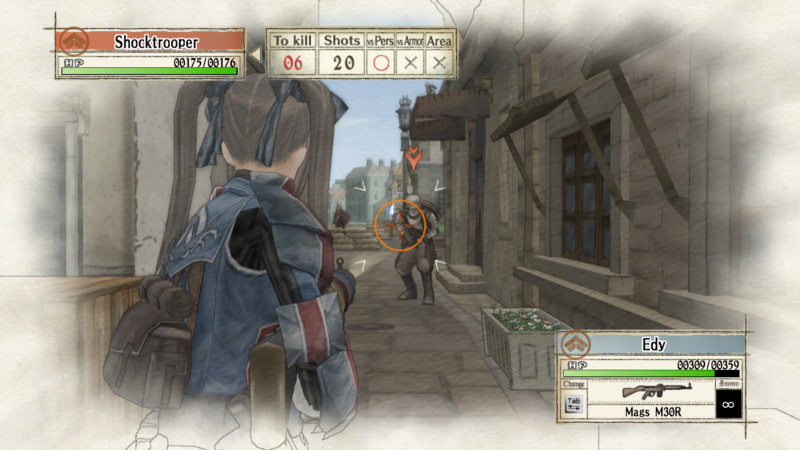
After using your action and exhausting the movement gauge, you will be able to return to the Command Mode, fully content that you have ended the life of some guy who may have had a loving wife and three kids. Be advised that the repeated use of the same unit has certain penalties tied to it, so you will not be owning the map with a single character… at least in theory. Once you spend all the Command Points, your turn ends and now the AI has a shot at you. This exchange will continue until you either reach your objective or the enemy manages to successfully hinder you one way or another. There is also the 20-turn limit that counts as an automatic defeat – if you have somehow managed to get stalled that long and not outright overrun, congratulations, you have done the impossible as far as I’m concerned.
Of course, Valkyria Chronicles is not exclusively a sequence of battles, as there are also cutscenes… a lot of those, sometimes tedious, cutscenes. The main interface is stylized to resemble a book, with different paragraphs being either a battle or a cutscene. Apart from that, the ‘book’ has tabs with character biographies, weapon types, descriptions of locations, lore, awards and skirmishes (a few new ones will get unlocked if you finish the game). All of that stuff gets gradually updated as you progress further along the story. Additionally, there is also a submenu where you can micromanage your squad and spend previously earned experience points. It all sounds organized as hell, but, unfortunately, there are some navigational issues that were, shall we say, mildly annoying even on the console.
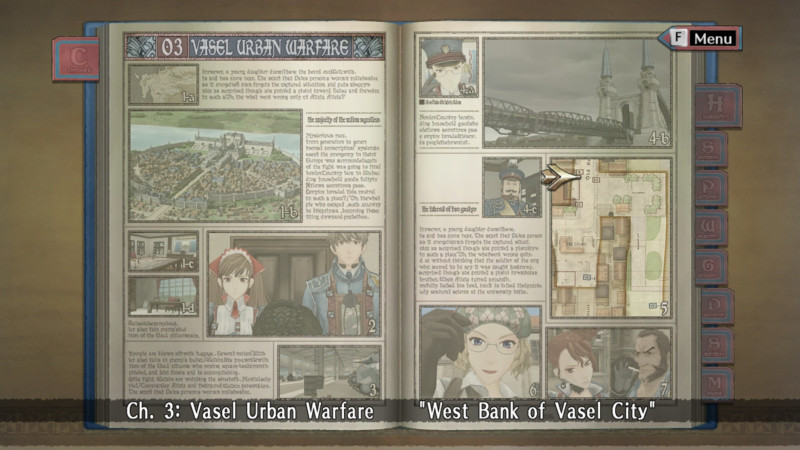
In 2008, when I bought the game on release for the PS3, it felt a bit easy. Back then, I would consider myself tactically competent, but nothing more. Of course, choosing a higher difficulty level would have been the proper course of action. Unfortunately, the developers decided against giving me that option as there is only one default difficulty. If you are playing Valkyria Chronicles for the first time, the two main elements most likely to make the game challenging for you will be: a) unfamiliarity with the missions (you are playing it for the first time after all) and b) the enemy's numerical superiority.
The first point is very much in Valkyria Chronicles's favor. The missions and maps are varied enough not to get repetitive, with some twists and turns along the way, boss units and the like. The same thing cannot be said about the number of enemies you are forced to face. Not only do they outnumber you when you are attacking their fortified positions, but they can also spawn seemingly endless reinforcements from their Camps. Why is this a problem when other games tend to do exactly that? Well, partly because it is a symptom of a more serious problem they were trying to correct. That problem would be the AI’s general incompetence.
Many times, you will experience enemy soldiers just wasting their Command Points by running back and forth in front of your troops with no clear idea of what they are doing. Very rarely will they even contemplate taking cover behind sandbags, and when you finally see them doing that, it is because they were placed there since the beginning of the mission. The AI also has the habit of leaving some of its Command Points unused when it ends its turn, instead of pounding your foolishly exposed tank for all it's worth (the destruction of the command tank means automatic game over). Because of this, the developer decided to take the ‘quantity over quality’ approach. Not to say the AI does not have its moments of clarity, although those are mostly scripts that seem to activate when specific requirements are met.

For example, every tank in the game has a weak point in the form of a radiator required for the Ragnite-powered engine. It generally requires only a single hit from a cannon or an AT lance for the whole tank to be destroyed. The developers made sure that if the AI had a shot at the radiator it would do exactly that, sometimes from very far away, with quite suspect pinpoint accuracy. Another would be when you leave your Base Camp undefended, only to suddenly find an enemy Scout sidestepping your forces outside of their overwatch/reaction fire range and then dashing straight to capture the flag, giving you a game over.
As charmingly challenging as those scripts may sound, they carry their own problems that are readily apparent in the “Challenges of the Edy Detachment” DLC. To make those missions difficult, the developers opted for an almost fully scripted approach which resembles a puzzle game where the player is forced to find the ‘correct’ way to win. Design like this encourages save-scumming – especially if you want to be awarded the ‘A’ rating – and successfully kills any kind of replay value.
But this is not the biggest failing of Valkyria Chronicles, oh no. The biggest failing of this game is its rating system. At the end of every mission, you are graded and awarded with an appropriate amount of points that you later use for troop training and R&D. Simple enough, if not for a single problem. The rating takes into account only a single factor – speed. Or to be more precise, the amount of turns it takes to complete the mission objective. Not the number of enemies you managed to eliminate, nor the losses you sustained, only the number of turns… and that is absolute horseshit.
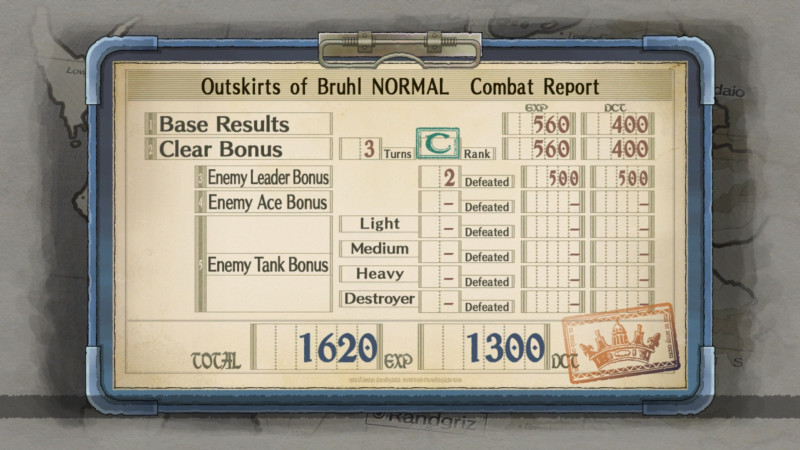
While killing more enemies gives you some additional points, they are marginal compared to getting a higher rating. Let’s say you got a ‘B’ and managed to kill all enemy soldiers - it does not matter, getting an ‘A’ without killing anyone would still earn you more points. What this encourages is a single tactic that throws any kind of defensive thinking and planning out the window, focusing exclusively on finishing most missions in no more that 2-3 turns. To even manage such a feat, you have to have high-level Scouts that, coupled with specific Orders, become overpowered enough to be gamebreaking. And speaking of ‘gamebreaking’, the skirmish battles that are not part of the main story also earn you points… and you can do them repeatedly, as much as you want. See the problem?
It's like the developers decided to focus on adjusting the difficulty around the concept of speed above all else, making other elements of the system totally pointless. Let’s take R&D for example: While upgrading the semi-automatic rifle, you will reach a fork where you can produce models that focus on accuracy, firepower or negative stat effects. My question is, what for? Having options is nice and all, but, ultimately, why would I need anything else than more firepower to get in close and punch my way through the enemy positions on the way to my objective (usually their Base Camp)?
You have all these various mechanics supported by a versatile upgrade system that give you all the necessary tactical depth, but then it all gets thrown away because the developer chose to enforce a specific playstyle. Any way you look at it, this is bad game design. Not to mention how unfair and disappointing it feels, given how the game's turn-based system as a whole is still solid enough to work despite all these shortcomings (which could have been easily eliminated through some proper balancing).

At its core, Valkyria Chronicles is a story about war, friendship (the brothers/sisters-in-arms kind), love and prejudice. And it would have been a much better one if not for the goddamn two main leads I mentioned already, Welkin Gunther and Alicia Melchiott. They are the apex of all the typical idiotic, naïve and cringe-worthy anime clichés. Believe me when I say this, as I have seen my fair share of those. As soon as they meet, you immediately realise they are destined to be all mushy-mushy by the end of the game.
Welkin is portrayed as a nature-loving sort – to the point of it becoming awkward for the player and other characters alike – who utilizes his knowledge in an effort to level the odds he and those under his command face. While not all bad, some of his obsession-colored wisdom makes you question his sanity. He’s like the perfect Otaku - functions normally on a day to day basis, but all the bets are off once he's faced with something flower or bug-related. Then there is Alicia, who wants to be a baker… and that is pretty much it. Where Welkin is at least memorable for his deviation, Alicia comes off as a blank slate, with nothing there to make her stand out aside from the plot-related events. As one would expect, the interactions between them range from bearable to embarrassing.
Thankfully, when it comes to creating unappealing characters, the developers somehow managed to limit themselves only to these two. After what I already said, I know this will be hard to believe, but the rest of the cast is pretty solidly written, including the antagonists, which is not exactly a small feat. The contrast can be quite jarring when you look, for example, at Selvaria Bles, Alicia’s counterpart on the Imperial side. A character with a detailed background, established motivations, and an arc the main heroine can only dream about having. Those are the reasons that make her the fan favorite and not Alicia. Also, if you see someone criticizing Selveria’s distractingly large bust, it will be obvious that this person does not understand one of the most important pairing in video games, ‘Tits and Turns’.
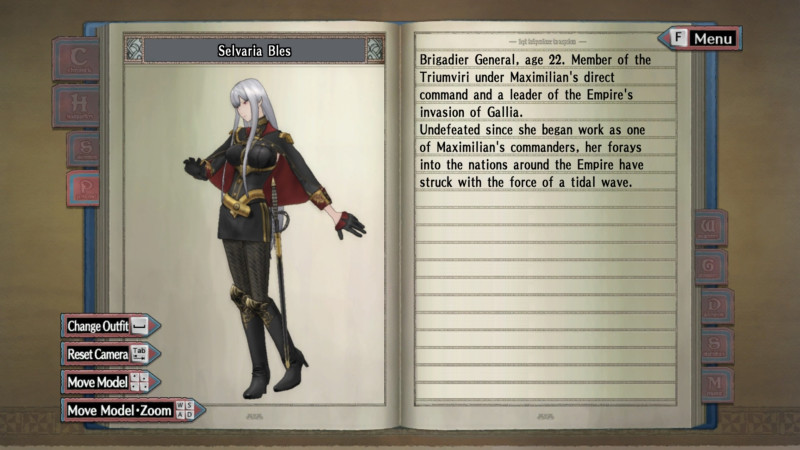
Another strong point in Valkyria Chronicles's favor is how it utilizes those characters to portray both sides of the conflict. I cannot stress enough that, for a game that is far from being a true depiction of war, it still manages to get the most fundamental point across – The Autocratic East Europan Imperial Alliance, for all its territorial ambition and prejudice towards the Darcsen, is not the Empire of Evil, nor, for that matter, is Gallia the Champion of Freedom.
Before we go further, it is imperative to explain who the Darcsen are. Long ago, the continent known today as Europa was ruled primarily by the Darcsen tribes, an ethnicity characterized by their dark blue-black hair. The various tribes warred against each other with powerful Ragnite weapons, causing countless deaths and destruction. This state of affairs lasted until the warrior race of the Valkyrur came from the north. The conflict that broke out between these two factions eventually saw the downfall of the Darcsen rule and marked them with the stigma of all their wrongdoings. Or at least that is what is written in the history books.
But all that happened almost two millennia ago. The Valkyrur are no more, with so little evidence of them remaining that some people even doubt they'd ever existed beyond the realm of fairytales and myth. The Darcsen, on the other hand, still live throughout Europa, without a country to call their own. The prejudice following them tends to take various forms, depending on where they reside. In Gallia, it takes the form of negative stereotypes, but in the Empire, their persecution is actively encouraged by the authorities. They are also being locked away in concentration camps and used primarily as forced labor in Ragnite mines. They are basically the Jews of this story without being the Jews.
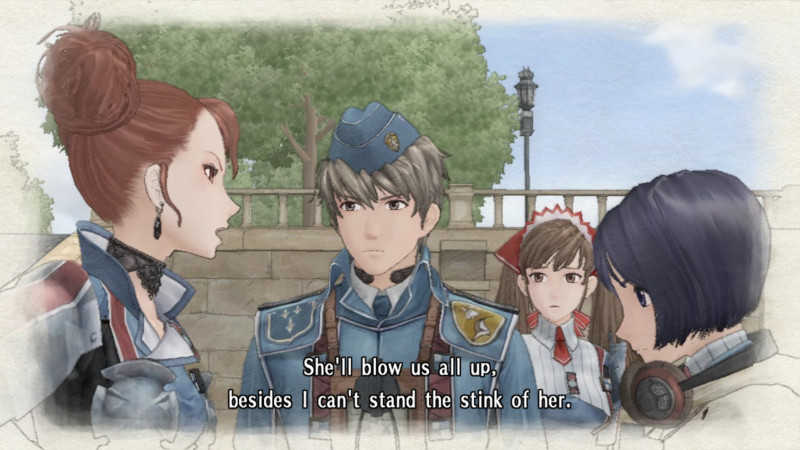
Now, to go back to the previous point. While Valkyria Chronicles clearly establishes who its villains and its heroes are, at the same time, it also shows that nothing is clear-cut, nothing is black and white. Every character is different – be it this side or the other – with different motivations and reasons for what they do.
A pragmatic Imperial prince that inspires absolute loyalty, yet is still convinced he can count only on himself.
A respected Gallian officer with a stellar career, unable to put the ghost of her past to rest.
A commander of the fallen Kingdom of Fhirald who currently fights for the Empire to pay with this for his country’s independence.
An honest and straightforward Corporal in the Gallian Militia, also a racist.
And so on and so forth. The game even goes out of its way to remind you at one point that those nameless grunts you kill without a second thought are just normal men, not some faceless monsters. While such moments are not exactly subtle most of the time, you have to give credit where credit is due.
But of course this would not be a game from Japan without some supernatural/fantasy/science-fiction elements slapped on it. This is where the Valkyria from the title come in. As already mentioned, the Valkyrur were an ancient warrior race, usually depicted as females armed with lances and shields. So why am I talking about something that seems like a major plot point only at the end? Because the Valkyria really are gone and have been for a long time. What remains of them are a few relics and some descendants, and while they are unimaginably powerful if used correctly, they are just that – remains of a bygone era, ultimately unable to alter the world in any significant way.
At the end of the day, Valkyria Chronicles does not tell you to find a cure for racial hatred, defeat the Empire or any other of those heroic world saving achievements you would expect from a game with a strong JRPG pedigree. What it does order you, is to survive a war from the perspective of a small squad, one of the many that are fighting in it. Also, a beach episode; can't get by without it (and to add insult to injury, you have to fork over some of your points to unlock it).
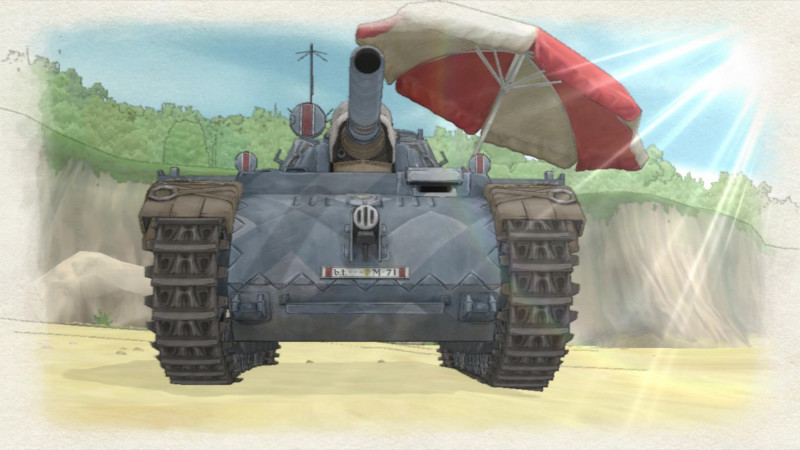
Like in any good TRPG, you will be able to choose from a wide variety of squadmates (around 50), each having their own backstories, quirks, likes, dislikes, allergies, potentials, and sexual preferences. You will not understand the true meaning of the word ‘diversity’ until you get to know the soldiers under your command. Which is not to say that this is the usual parade of spiky-haired emo individuals, although it tends to have the odd man out… like Jann. With age ranging from 12 to 65 years – and yes, it means you are commanding child soldiers, not that this has ever stopped you from sending all those other teens into harm’s way to defeat the ultimate evil – most of them are either older veterans of EWI or young people in the vicinity of the age of consent.
The developers, to their credit, went further than to just design a varied cast with a lot of flavor info added on top. No, each of those attributes has its impact on the gameplay. For example, there is a unit with pollen allergy - if he or she runs onto a grassy plain, their HP will start going down. A female soldier who ‘fancies women’ and ‘hates men’ (read: a lesbian) may get a stat boost near females or a stat penalty near men. Then there are the ‘who likes who’ moments that enable another unit to join the attack. It is a really nifty concept, in which secondary characters do not feel like expendable pawns even though they may not take an active role in the story. What is also important to mention is that troops are trained and level up not as individuals but as the entire class, which eliminates the discrepancy between units recruited earlier and ones that appear later in the game as additional militiamen/women become available to recruit.
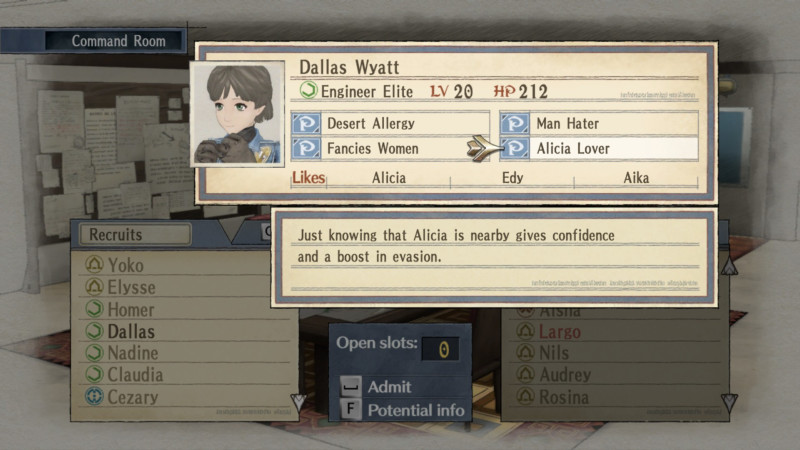
Let’s be clear, Valkyria Chronicles is not a perfect game. Its gameplay is noticeably flawed, it has limited replayability and a story chockfull of idiotic clichés. Yet even all those drawbacks combined cannot overshadow what truly is a good game. When it was initially released on the PlayStation 3, everything about it was new: the quasi-European setting circa 1935, the CANVAS graphics engine that resembles a watercolor painting in motion, the fresh take on turn-based gameplay. Well, maybe except SEGA’s marketing – which could explain the poor sales – that still aspires to the golden standard of ‘fuck all, why bother’ even after these six years, if this latest release is anything to go by.
Thankfully, this time SEGA only had to release the game and watch the money roll in. An established loyal fanbase and years of positive word of mouth made sure that on the first day, Valkyria Chronicles topped Steam charts ahead of blockbuster hits like Call of Duty: Advanced Warfare and Assassin's Creed Unity that were also launched back then. Furthermore, the port was way, way better quality-wise than anyone dared to expect at the time, particularly based on previous experience. Now if only SEGA continues this trend, there could be a pretty penny for them to earn, and it would make a lot of people happy, myself included.
You can buy Valkyria Chronicles on Steam.
PROLOGUE
Valkyria Chronicles is a formerly PS3-exclusive tactical roleplaying game, originally released by SEGA in the second half of 2008. While not exactly a flop, its sales were poor outside of Japan, even though the game received favorable reviews from the gaming press. The following year saw a noticeable rise in sales that could be attributed to factors such as positive word-of-mouth, a drop in price and the release of an anime based on the game.
Ultimately, SEGA decided to authorize two additional games in the series for the PlayStation Portable, of which the third one was not officially released in the West, because of the – again – disappointing sales of Valkyria Chronicles 2. That of course did not stop the fans from translating it themselves, as Valkyria Chronicles already had a strong cult-following by that time. Regardless, it seemed that this would be as far as the franchise would go. Yet fate had other things in store.
Unbeknownst to most, SEGA was keeping the franchise alive in Japan. After the release of Valkyria Chronicles 3 Extra Edition around the end of 2011, there was also the browser/mobile-based card game Valkyria Chronicles Duel (2012) and Project X Zone (2013). Published by Namco for the 3DS, Project X Zone was not a proper part of the series, but a crossover game that featured some of the VC characters. It was, however, a TRPG and sold way more in the West than projected.
Then something happened... The planets aligned, old game franchise necrophilia was outlawed, Grimoire finally came out, while someone high enough in the SEGA hierarchy looked upon their console games catalogue and the growing trends in online sales and thought, “Hmm…”. The unthinkable happened - SEGA discovered the PC.
With porting underway, the project was placed under tighter security than the plan to attack the U.S. Pacific Fleet in Pearl Harbor, probably because of the fear that people would think SEGA was insane to actually sink money into this borderline experimental concept of bringing old console games onto that so-called ‘insignificant’ PC market. On the 28th of October, 2014, the bombs fell to the general feeling of surprise and shock, and Valkyria Chronicles was announced for the PC with only a single blip of warning on the PEGI radar. The game was released barely two weeks later.

CHAPTER 1 - INTRODUCTION
Valkyria Chronicles is something that probably could not have gestated outside of that divergent, wonderful and perverted country that is Japan. Mainly because the whole game is basically composed of a few chapters taken from the European 20th century history books, mixed with the usual assortment of typical Japanese clichés that seem to plague their every medium like some relentless bullet-point list bestowed upon them by the gods themselves. You will not see a Western developer doing this, especially as the game goes into some of those touchy subjects like, say, racial discrimination, genocide and other such stuff. Not a safe topic to be sure, better make a dumb World War 2 shooter instead and avoid themes that could offend someone, somewhere, regardless of your best intentions. It is not good for business.
The game takes place in Europa, which is a fictional depiction of Europe. The year is 1935 and the continent is dominated by two superpowers: The commonwealth of allied democracies known as the Atlantic Federation (think NATO) in the west and The Autocratic East Europan Imperial Alliance in the east. Caught between those two giants is the Principality of Gallia, a small, neutral country that possesses large deposits of Ragnite, a mineral crucial enough for a growing economy to have been the main driving force behind the First Europan War twenty years ago. If you somehow did not notice, Gallia is basically the Low Countries (Belgium, The Netherlands and Luxembourg) and Ragnite – with its multiple applications in different fields, ranging from powering engines to medicine – is oil.

The game starts after the beginning of the Second Europan War. With the Federation on the defensive, the Empire decides to invade Gallia with the objective to secure a steady source of Ragnite to sustain its war effort. Here we are introduced to the two main leads, Welkin and Alicia, as they are forced to evacuate from their hometown of Bhrul. Bhrul is located on the border with the Empire and is one of the first places to fall in the face of the sudden offensive. From there, they move to Randgriz, the capital city, and join the militia forces. Being a university student, Welkin had finished a mandatory officer's course, which is why he now gets promoted to lieutenant and given command over Squad 7 with Alicia as his non-com officer.
I think it is important to point out that Valkyria Chronicles is one of the few games that have a legitimate, honest-to-god reason to have underage characters as protagonists. Gallia’s universal conscription (probably based on the Swiss model) requires that all able-bodied male and female citizens join the militia and fight alongside the regular army in times of war. Thanks to this policy, even a small country like Gallia managed to defend its independence in the First Europan War.
From here on out, your task as the player will be to lead men and women under your command through a series of battles and skirmishes, while trying not to get half of your squad killed in the process. All in all, it is a fairly straightforward introduction that clearly establishes the final objective you will strive to achieve throughout the game - repel the Empire. It also presents you with a few short battles that will acquaint you with the basic gameplay.

CHAPTER 2 - GAMEPLAY
Probably one of the main advantages of Valkyria Chronicles is its unique tactical turn-based system that, while not diverging from the standard formula for games of this type, still manages to alter the perspective of certain elements radically enough to gain a dynamic never before seen in any turn-based game. The difference is profound and, what is more important, it works. Most of the time.
The Battle of Live Tactical Zones (BLiTZ) divides the battle into two modes. The first one is the Command Mode where you are able to oversee the battlefield from above, as if you were looking on a map. All your units are marked on it, as well as the enemy units that are within the line of sight of your forces. Apart from giving you the general feel of the tactical situation, this mode also allows you to issue Orders and allocate Command Points. Command Points are – as the name would imply – points which are issued every turn to you and the enemy. Each point allows one of your units to take action (two points are required if said unit is a tank). Orders are mostly, but not only, stat related boosts, and require various amounts of points to issue. You only have a few at your disposal at the beginning, but you can acquire new ones as the game progresses.

So far, this is pretty much the standard TRPG formula. That is, until you issue a Command Point to one of your units. As soon as you do that, the view shifts to a third person perspective, and the gameplay becomes sort of pseudo-real time where you are able to directly control the chosen unit. This is the Action Mode. Please note that this does not make it a third person shooter, as movement and shooting are done separately. Once in direct control, your unit is entitled to a certain distance it can move and a single action it can perform (there are some environment related events that do not use up the action). All this depends on the class of the unit you are currently using. Suffice to say, most of the ‘actions’ that you will be performing are about making the other guy die for his country.
There are five infantry classes in the game:
- The Scout is armed with a medium-long range semi-automatic rifle, has weak body-armor and will most likely not survive if left in the open, but, compared to the other classes, its main advantage comes from being able to travel the longest distance in combat.
- The Shocktrooper is equipped with a submachine gun and sports heavy armor. This is the deadliest class in the game when encountered at close range, and its only drawback is its relatively short movement range.
- The Lancer, with its AT lance and the best armor in the game, is your primary anti-tank unit. Its movement range is comparable to that of a Shocktrooper, which makes it of limited use when facing infantry.
- The Engineer is similar to a Scout but even weaker combat-wise. This unit is able to repair your command tank, disarm mines, refill sandbags, and resupply ammo to your troops.
- The Sniper is unable to withstand any kind of damage and has by far the most limited movement of all classes, but is essential in eliminating enemies from afar.

Now, if you are familiar with some of the classic western TRPGs – like Jagged Alliance or X-COM – you will be familiar with the term ‘Overwatch’ or ‘Reaction Fire’. The developers of Valkyria Chronicles decided to use a similar mechanic… minus the action points. While in Action Mode, if you get too close to an enemy solider that is facing your way, he will fire upon you even though it is not his turn (this does not apply to Lancers and Snipers). And he will keep firing until you get out of range, your unit takes too much damage and gets downed, or you shift into the aiming stance. This reactive fire mechanic, which applies to both enemy and player units depending on whose turn it is, successfully adds some dynamism to the gameplay and makes positioning crucial.

After using your action and exhausting the movement gauge, you will be able to return to the Command Mode, fully content that you have ended the life of some guy who may have had a loving wife and three kids. Be advised that the repeated use of the same unit has certain penalties tied to it, so you will not be owning the map with a single character… at least in theory. Once you spend all the Command Points, your turn ends and now the AI has a shot at you. This exchange will continue until you either reach your objective or the enemy manages to successfully hinder you one way or another. There is also the 20-turn limit that counts as an automatic defeat – if you have somehow managed to get stalled that long and not outright overrun, congratulations, you have done the impossible as far as I’m concerned.
Of course, Valkyria Chronicles is not exclusively a sequence of battles, as there are also cutscenes… a lot of those, sometimes tedious, cutscenes. The main interface is stylized to resemble a book, with different paragraphs being either a battle or a cutscene. Apart from that, the ‘book’ has tabs with character biographies, weapon types, descriptions of locations, lore, awards and skirmishes (a few new ones will get unlocked if you finish the game). All of that stuff gets gradually updated as you progress further along the story. Additionally, there is also a submenu where you can micromanage your squad and spend previously earned experience points. It all sounds organized as hell, but, unfortunately, there are some navigational issues that were, shall we say, mildly annoying even on the console.

CHAPTER 3 - DIFFICULTY
In 2008, when I bought the game on release for the PS3, it felt a bit easy. Back then, I would consider myself tactically competent, but nothing more. Of course, choosing a higher difficulty level would have been the proper course of action. Unfortunately, the developers decided against giving me that option as there is only one default difficulty. If you are playing Valkyria Chronicles for the first time, the two main elements most likely to make the game challenging for you will be: a) unfamiliarity with the missions (you are playing it for the first time after all) and b) the enemy's numerical superiority.
The first point is very much in Valkyria Chronicles's favor. The missions and maps are varied enough not to get repetitive, with some twists and turns along the way, boss units and the like. The same thing cannot be said about the number of enemies you are forced to face. Not only do they outnumber you when you are attacking their fortified positions, but they can also spawn seemingly endless reinforcements from their Camps. Why is this a problem when other games tend to do exactly that? Well, partly because it is a symptom of a more serious problem they were trying to correct. That problem would be the AI’s general incompetence.
Many times, you will experience enemy soldiers just wasting their Command Points by running back and forth in front of your troops with no clear idea of what they are doing. Very rarely will they even contemplate taking cover behind sandbags, and when you finally see them doing that, it is because they were placed there since the beginning of the mission. The AI also has the habit of leaving some of its Command Points unused when it ends its turn, instead of pounding your foolishly exposed tank for all it's worth (the destruction of the command tank means automatic game over). Because of this, the developer decided to take the ‘quantity over quality’ approach. Not to say the AI does not have its moments of clarity, although those are mostly scripts that seem to activate when specific requirements are met.

For example, every tank in the game has a weak point in the form of a radiator required for the Ragnite-powered engine. It generally requires only a single hit from a cannon or an AT lance for the whole tank to be destroyed. The developers made sure that if the AI had a shot at the radiator it would do exactly that, sometimes from very far away, with quite suspect pinpoint accuracy. Another would be when you leave your Base Camp undefended, only to suddenly find an enemy Scout sidestepping your forces outside of their overwatch/reaction fire range and then dashing straight to capture the flag, giving you a game over.
As charmingly challenging as those scripts may sound, they carry their own problems that are readily apparent in the “Challenges of the Edy Detachment” DLC. To make those missions difficult, the developers opted for an almost fully scripted approach which resembles a puzzle game where the player is forced to find the ‘correct’ way to win. Design like this encourages save-scumming – especially if you want to be awarded the ‘A’ rating – and successfully kills any kind of replay value.
But this is not the biggest failing of Valkyria Chronicles, oh no. The biggest failing of this game is its rating system. At the end of every mission, you are graded and awarded with an appropriate amount of points that you later use for troop training and R&D. Simple enough, if not for a single problem. The rating takes into account only a single factor – speed. Or to be more precise, the amount of turns it takes to complete the mission objective. Not the number of enemies you managed to eliminate, nor the losses you sustained, only the number of turns… and that is absolute horseshit.

While killing more enemies gives you some additional points, they are marginal compared to getting a higher rating. Let’s say you got a ‘B’ and managed to kill all enemy soldiers - it does not matter, getting an ‘A’ without killing anyone would still earn you more points. What this encourages is a single tactic that throws any kind of defensive thinking and planning out the window, focusing exclusively on finishing most missions in no more that 2-3 turns. To even manage such a feat, you have to have high-level Scouts that, coupled with specific Orders, become overpowered enough to be gamebreaking. And speaking of ‘gamebreaking’, the skirmish battles that are not part of the main story also earn you points… and you can do them repeatedly, as much as you want. See the problem?
It's like the developers decided to focus on adjusting the difficulty around the concept of speed above all else, making other elements of the system totally pointless. Let’s take R&D for example: While upgrading the semi-automatic rifle, you will reach a fork where you can produce models that focus on accuracy, firepower or negative stat effects. My question is, what for? Having options is nice and all, but, ultimately, why would I need anything else than more firepower to get in close and punch my way through the enemy positions on the way to my objective (usually their Base Camp)?
You have all these various mechanics supported by a versatile upgrade system that give you all the necessary tactical depth, but then it all gets thrown away because the developer chose to enforce a specific playstyle. Any way you look at it, this is bad game design. Not to mention how unfair and disappointing it feels, given how the game's turn-based system as a whole is still solid enough to work despite all these shortcomings (which could have been easily eliminated through some proper balancing).

CHAPTER 4 - THE STORY AND CHARACTERS
At its core, Valkyria Chronicles is a story about war, friendship (the brothers/sisters-in-arms kind), love and prejudice. And it would have been a much better one if not for the goddamn two main leads I mentioned already, Welkin Gunther and Alicia Melchiott. They are the apex of all the typical idiotic, naïve and cringe-worthy anime clichés. Believe me when I say this, as I have seen my fair share of those. As soon as they meet, you immediately realise they are destined to be all mushy-mushy by the end of the game.
Welkin is portrayed as a nature-loving sort – to the point of it becoming awkward for the player and other characters alike – who utilizes his knowledge in an effort to level the odds he and those under his command face. While not all bad, some of his obsession-colored wisdom makes you question his sanity. He’s like the perfect Otaku - functions normally on a day to day basis, but all the bets are off once he's faced with something flower or bug-related. Then there is Alicia, who wants to be a baker… and that is pretty much it. Where Welkin is at least memorable for his deviation, Alicia comes off as a blank slate, with nothing there to make her stand out aside from the plot-related events. As one would expect, the interactions between them range from bearable to embarrassing.
Thankfully, when it comes to creating unappealing characters, the developers somehow managed to limit themselves only to these two. After what I already said, I know this will be hard to believe, but the rest of the cast is pretty solidly written, including the antagonists, which is not exactly a small feat. The contrast can be quite jarring when you look, for example, at Selvaria Bles, Alicia’s counterpart on the Imperial side. A character with a detailed background, established motivations, and an arc the main heroine can only dream about having. Those are the reasons that make her the fan favorite and not Alicia. Also, if you see someone criticizing Selveria’s distractingly large bust, it will be obvious that this person does not understand one of the most important pairing in video games, ‘Tits and Turns’.

Another strong point in Valkyria Chronicles's favor is how it utilizes those characters to portray both sides of the conflict. I cannot stress enough that, for a game that is far from being a true depiction of war, it still manages to get the most fundamental point across – The Autocratic East Europan Imperial Alliance, for all its territorial ambition and prejudice towards the Darcsen, is not the Empire of Evil, nor, for that matter, is Gallia the Champion of Freedom.
Before we go further, it is imperative to explain who the Darcsen are. Long ago, the continent known today as Europa was ruled primarily by the Darcsen tribes, an ethnicity characterized by their dark blue-black hair. The various tribes warred against each other with powerful Ragnite weapons, causing countless deaths and destruction. This state of affairs lasted until the warrior race of the Valkyrur came from the north. The conflict that broke out between these two factions eventually saw the downfall of the Darcsen rule and marked them with the stigma of all their wrongdoings. Or at least that is what is written in the history books.
But all that happened almost two millennia ago. The Valkyrur are no more, with so little evidence of them remaining that some people even doubt they'd ever existed beyond the realm of fairytales and myth. The Darcsen, on the other hand, still live throughout Europa, without a country to call their own. The prejudice following them tends to take various forms, depending on where they reside. In Gallia, it takes the form of negative stereotypes, but in the Empire, their persecution is actively encouraged by the authorities. They are also being locked away in concentration camps and used primarily as forced labor in Ragnite mines. They are basically the Jews of this story without being the Jews.

Now, to go back to the previous point. While Valkyria Chronicles clearly establishes who its villains and its heroes are, at the same time, it also shows that nothing is clear-cut, nothing is black and white. Every character is different – be it this side or the other – with different motivations and reasons for what they do.
A pragmatic Imperial prince that inspires absolute loyalty, yet is still convinced he can count only on himself.
A respected Gallian officer with a stellar career, unable to put the ghost of her past to rest.
A commander of the fallen Kingdom of Fhirald who currently fights for the Empire to pay with this for his country’s independence.
An honest and straightforward Corporal in the Gallian Militia, also a racist.
And so on and so forth. The game even goes out of its way to remind you at one point that those nameless grunts you kill without a second thought are just normal men, not some faceless monsters. While such moments are not exactly subtle most of the time, you have to give credit where credit is due.
But of course this would not be a game from Japan without some supernatural/fantasy/science-fiction elements slapped on it. This is where the Valkyria from the title come in. As already mentioned, the Valkyrur were an ancient warrior race, usually depicted as females armed with lances and shields. So why am I talking about something that seems like a major plot point only at the end? Because the Valkyria really are gone and have been for a long time. What remains of them are a few relics and some descendants, and while they are unimaginably powerful if used correctly, they are just that – remains of a bygone era, ultimately unable to alter the world in any significant way.
At the end of the day, Valkyria Chronicles does not tell you to find a cure for racial hatred, defeat the Empire or any other of those heroic world saving achievements you would expect from a game with a strong JRPG pedigree. What it does order you, is to survive a war from the perspective of a small squad, one of the many that are fighting in it. Also, a beach episode; can't get by without it (and to add insult to injury, you have to fork over some of your points to unlock it).

CHAPTER 5 – SQUAD 7
Like in any good TRPG, you will be able to choose from a wide variety of squadmates (around 50), each having their own backstories, quirks, likes, dislikes, allergies, potentials, and sexual preferences. You will not understand the true meaning of the word ‘diversity’ until you get to know the soldiers under your command. Which is not to say that this is the usual parade of spiky-haired emo individuals, although it tends to have the odd man out… like Jann. With age ranging from 12 to 65 years – and yes, it means you are commanding child soldiers, not that this has ever stopped you from sending all those other teens into harm’s way to defeat the ultimate evil – most of them are either older veterans of EWI or young people in the vicinity of the age of consent.
The developers, to their credit, went further than to just design a varied cast with a lot of flavor info added on top. No, each of those attributes has its impact on the gameplay. For example, there is a unit with pollen allergy - if he or she runs onto a grassy plain, their HP will start going down. A female soldier who ‘fancies women’ and ‘hates men’ (read: a lesbian) may get a stat boost near females or a stat penalty near men. Then there are the ‘who likes who’ moments that enable another unit to join the attack. It is a really nifty concept, in which secondary characters do not feel like expendable pawns even though they may not take an active role in the story. What is also important to mention is that troops are trained and level up not as individuals but as the entire class, which eliminates the discrepancy between units recruited earlier and ones that appear later in the game as additional militiamen/women become available to recruit.

EPILOGUE
Let’s be clear, Valkyria Chronicles is not a perfect game. Its gameplay is noticeably flawed, it has limited replayability and a story chockfull of idiotic clichés. Yet even all those drawbacks combined cannot overshadow what truly is a good game. When it was initially released on the PlayStation 3, everything about it was new: the quasi-European setting circa 1935, the CANVAS graphics engine that resembles a watercolor painting in motion, the fresh take on turn-based gameplay. Well, maybe except SEGA’s marketing – which could explain the poor sales – that still aspires to the golden standard of ‘fuck all, why bother’ even after these six years, if this latest release is anything to go by.
Thankfully, this time SEGA only had to release the game and watch the money roll in. An established loyal fanbase and years of positive word of mouth made sure that on the first day, Valkyria Chronicles topped Steam charts ahead of blockbuster hits like Call of Duty: Advanced Warfare and Assassin's Creed Unity that were also launched back then. Furthermore, the port was way, way better quality-wise than anyone dared to expect at the time, particularly based on previous experience. Now if only SEGA continues this trend, there could be a pretty penny for them to earn, and it would make a lot of people happy, myself included.
You can buy Valkyria Chronicles on Steam.
There are 59 comments on RPG Codex Review: Valkyria Chronicles











